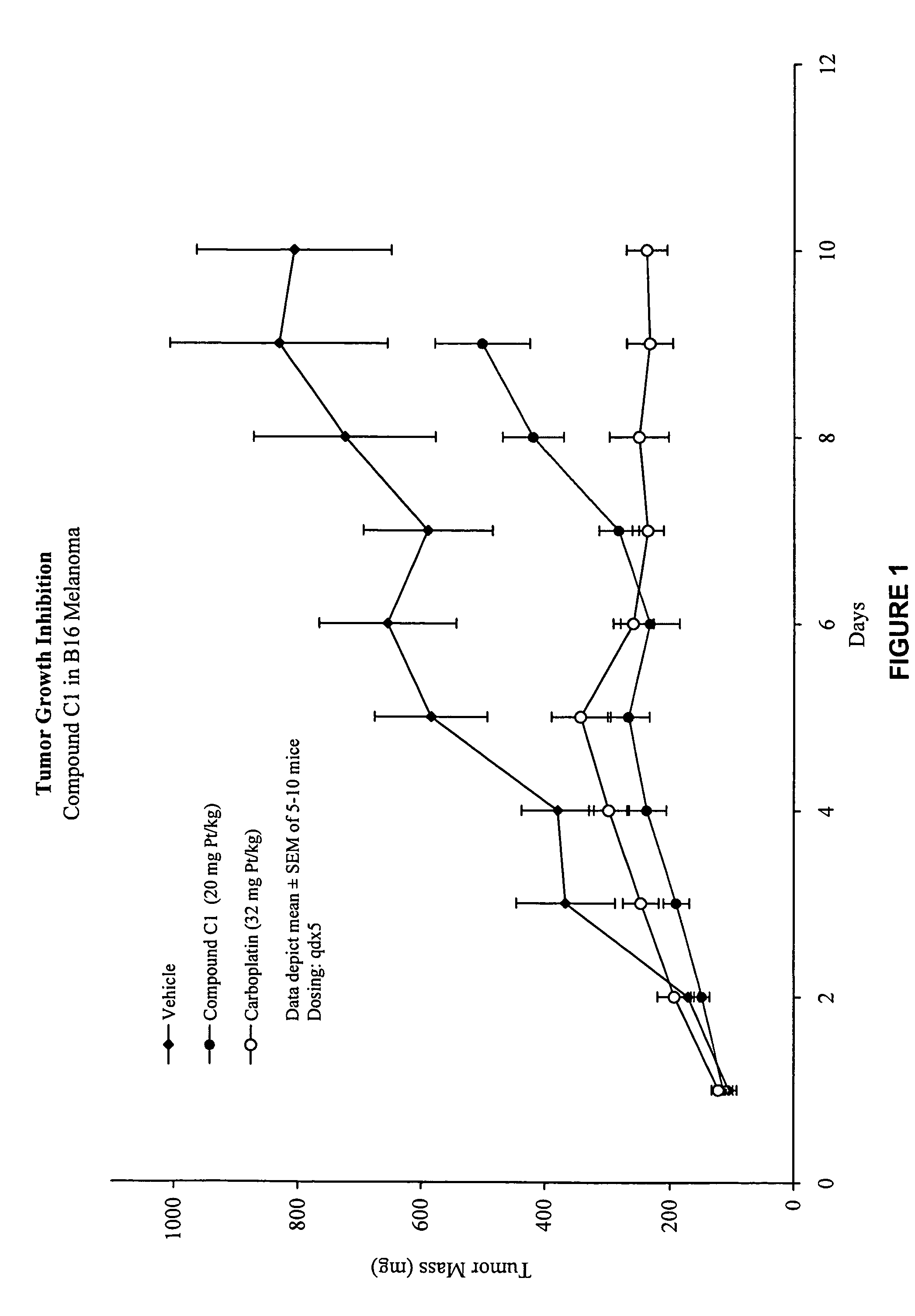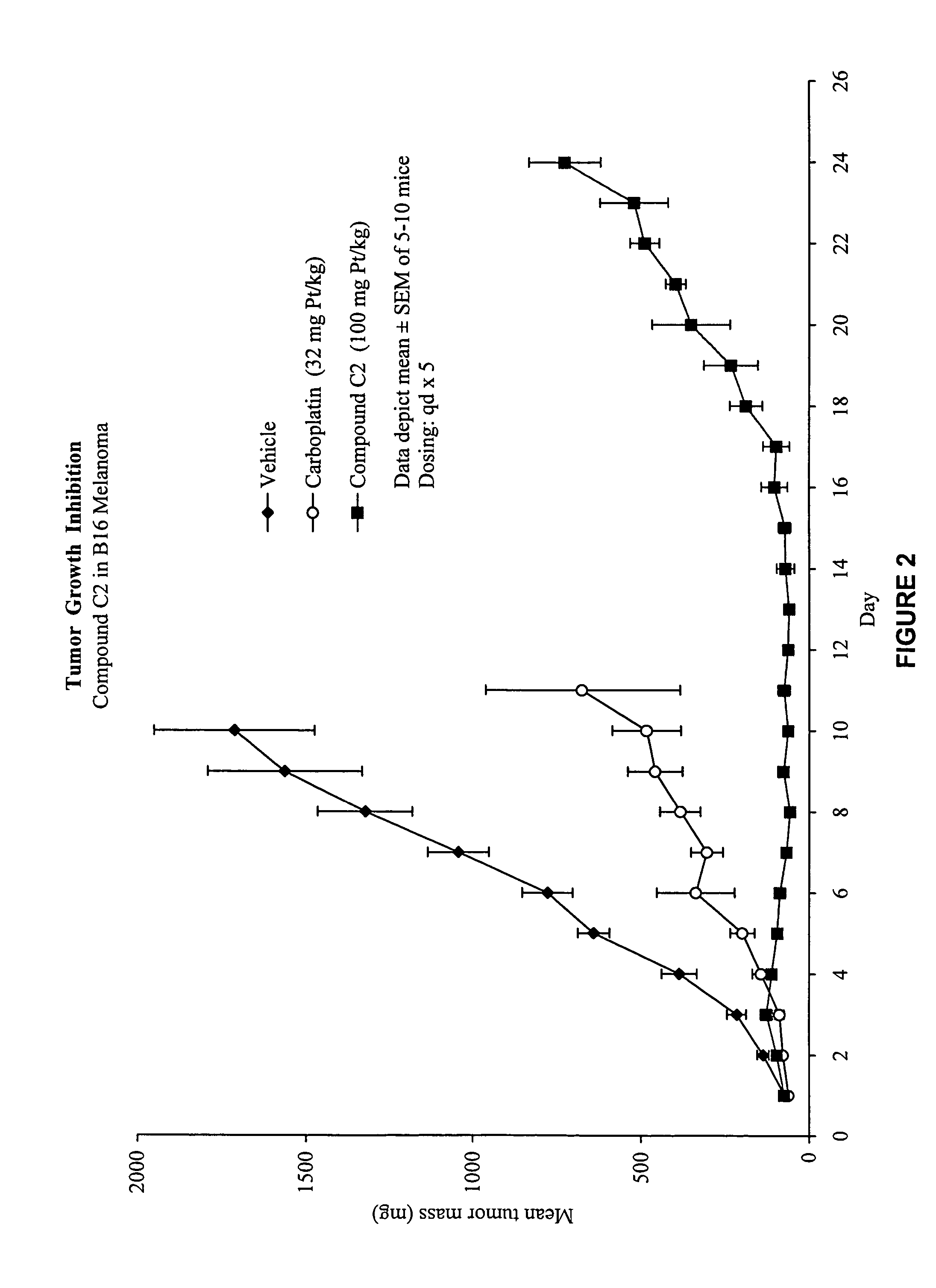Macromolecular platinum chelates
a platinum chelate, macromolecular technology, applied in the field of platinum complexes, can solve the problems of limited use of cisplatin and its therapeutic index, and relatively low
- Summary
- Abstract
- Description
- Claims
- Application Information
AI Technical Summary
Benefits of technology
Problems solved by technology
Method used
Image
Examples
example 1
Preparation of Platinating Solutions
[0670]A. Preparation of cis-diamminediaquaplatinum (II) Dinitrate (1a) Solution
[0671]A suspension of cisplatin (8.996 g, 29.98 mmol), AgNO3 (9.959 g, 58.62 mmol), 3-5 drops of 5% HNO3, and 190 mL of water were stirred overnight at about 23° C. in a foil-covered low actinic media bottle and then heated at 60-65° C. for 3.5 h. After cooling to ambient temperature, the mixture was filtered through a 0.22 μm filter to give a solution of 1a with a pH of approximately 2. A Pt and Ag analysis (ICP-OES) showed that it contained ca. 20,000-25,000 ppm of Pt and 4-14 ppm of Ag. Each preparation was analyzed for Pt, and, just prior to use, it was heated to 55° C. for 5 min then cooled to ambient temperature.
[0672]B. Preparation of 1R,2R-DACH-diaquaplatinum (II) Dinitrate (1b) Solution
[0673]A suspension of cis-1R,2R-diaminoccylohexane(DACH)dichloroplatinum (II) (2.99 g, 7.86 mmol), Ag(NO3) (2.6137 g, 15.38 mmol), 2-3 drops of 5% HNO3 and 56 mL of water were st...
example 2
Preparation of poly(HPMA)-Ama=Pt=(NH3)2
[0674]A. Preparation of MA-Ama-diEt (2)
[0675]A dry 3-neck, 125 mL flask equipped with a thermometer, a stir bar, a pressure equalizing addition funnel, and an Argon inlet was charged with 10.58 g (50.0 mmol) of diethylaminomalonate HCl, 10.62 g (105 mmol) dry triethylamine, and 70 mL of dry CH2Cl2. After dissolution, the mixture was cooled to 4° C. and 6.53 g (6.11 mL, 50 mmol) of methacryloyl chloride was added dropwise so that the temperature remained below 5° C., and the mixture was then stirred overnight at ambient temperature. White crystals of TEA-HCl were collected by filtration with a second crop being collected after cooling to −20° C. for 3 h. The filtrate was successively washed with 30 mL each of 1 M NaH2PO4, 5% NaHCO3, and brine. The CH2Cl2 layer was dried over anhydrous MgSO4 and the solvent removed in vacuo. Dry diethyl ether was added to the residue and the mixture was held at −20° C. overnight. A mass of white crystals were co...
example 3
Preparation of poly(HPMA)-GG-Ama=Pt=(NH3)2, 38 kDa
[0686]A. Poly(HPMA)-GG-Ama-diEt (10)
[0687]An oven-dried foil-covered 250 mL media bottle equipped with a stir bar and cap with a gas inlet valve and bubbler was charged with 1.80 g (5.04 mmol) of MA-GG-Ama-diEt 7, 6.49 g (45.33 mmol) of HPMA, 0.841 g (6.04 mmol)of p-nitrophenol (HONp), and 46.7 g of HPLC-grade acetone. The cap with Argon bubbler and valve was replaced and the mixture was stirred until dissolution then sparged again with Argon for 30 min. The cap was removed, and 0.40 g (0.398 mmol) of AIBN dissolved in 5 mL of acetone was added by syringe. The syringe was rinsed with 5 mL of acetone in 1 mL increments that were each added to the solution. The reaction mixture was sparged with Ar for 1 h more then immersed in a 50° C. water bath for 48 h. After cooling to ambient temperature the polymer was filtered through a medium glass frit, washed three times with 50 mL of diethyl ether and dried under a rubber dam to give 7.1 g o...
PUM
| Property | Measurement | Unit |
|---|---|---|
| average molecular weight distribution | aaaaa | aaaaa |
| average molecular weight distribution | aaaaa | aaaaa |
| average molecular weight distribution | aaaaa | aaaaa |
Abstract
Description
Claims
Application Information
 Login to View More
Login to View More - R&D
- Intellectual Property
- Life Sciences
- Materials
- Tech Scout
- Unparalleled Data Quality
- Higher Quality Content
- 60% Fewer Hallucinations
Browse by: Latest US Patents, China's latest patents, Technical Efficacy Thesaurus, Application Domain, Technology Topic, Popular Technical Reports.
© 2025 PatSnap. All rights reserved.Legal|Privacy policy|Modern Slavery Act Transparency Statement|Sitemap|About US| Contact US: help@patsnap.com



